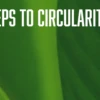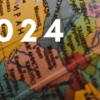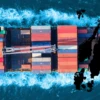How can digital IDs enable a more sustainable fashion industry?
Digital IDs provide customers with detailed information on how to care for and repair their garments, the origin of the raw materials used, the conditions under which they were produced and the authenticity of the items they have purchased. By providing greater transparency and insight into garment supply chains, digital IDs can help minimise unsustainable practices in the fashion industry and catalyse circular business models.
Product information for garments and textiles tends to be difficult and time-consuming to access. This is a major obstacle to building a sustainable circular economy for our industry. To address this, companies across the value chain are introducing data-driven solutions to increase transparency and deliver greater value for brands, consumers and the planet.
Textile circularity: it’s a jungle out there…
Rainforests and data. It’s not an obvious connection, you might think. But read on, and I hope to convince you otherwise. Recently, I’ve been reflecting a lot on rainforests and how they can help us think about the circular economy. As you no doubt know, rainforests are one of the world’s largest and most vital biomes, providing a home for millions of species. But surprisingly, rainforest soil is incredibly nutrient-poor. Pretty much infertile. So, how does one of the world’s most biodiverse ecosystems thrive in such a seemingly inhospitable setting?
The key is that most available nutrients are stored in either living or decaying vegetation, so few ever even make it down into the soil. Instead, plants and trees have adapted to absorb nutrients directly from the layer of decomposing plant matter – or “humus” – above the soil’s surface. Nothing is wasted because it is immediately absorbed and taken where it’s needed.
Now, what if we used returned or damaged clothes and textile products in the same way rainforest plants use nutrients? So, if a consumer returns a product, it’s like a leaf falling from a tree. And when a circular service provider takes the garment, repairs it and resells it? That’s like a rainforest plant reabsorbing the leaf’s nutrients and putting them back into circulation.
This approach allows us to make better use of the resources that exist already – saving the precious energy it takes to find new ones. But sadly, there’s a huge obstacle standing in the way of our using all these lovely “nutrients” more effectively. That problem is the data gap. It’s one of the main reasons for the persistently low rates of clothing resale and recycling.
We simply don’t have the data we need in the right places to make the right decisions. For instance, it’s currently very time-consuming for recyclers to check whether a garment contains harmful chemicals that could potentially contaminate recycling streams. Similarly, for renewal service providers, there’s still no unified system for extracting accurate information on used or returned products. It’s frustrating to think that the data we need to supercharge circular models is out there – all we need is a consolidated data-sharing framework to make it useful.
If we can achieve this as an industry, we’ll be able to work out much more quickly which items can be repaired, renewed or recycled. This will enable us to roll out textile resale and recycling on a much bigger scale. And this will doubtless have the knock-on effect of encouraging fashion and textile brands to increase the reparability and circular potential of their products.
Sound too good to be true? Well, this goal might be closer than you think! In this blog series, we’ll be unpacking the benefits and challenges of using digital ID systems in circular models. And we’ll be exploring how a range of industry players, from high fashion to mass-market, are already finding innovative ways to integrate data into the fashion and textiles value chain.
What role does data play in creating a circular economy for textiles?
We use data across all our Renewal Workshop operations at Bleckmann. We give every product that we renew and resell a unique digital ID, accessible via a Bar code. This contains the product’s original specifications and details of any repairs we’ve made. This data helps us to price goods correctly and provide accurate product descriptions on brands’ re-commerce sites.
Storing this data in a single, unified digital ID that stays with the garment means customers know exactly what product they’re getting, and what condition it’s in. That’s because our digital IDs are specific to the individual product, and not created per style. So, if there even are minor differences between different versions of a product, shoppers will know all the details.
But this is only the beginning of what data can do to help power the circular economy. We also look for trends in the data to help brands identify and fix potential product issues. For example, if there’s a particular product that we often see with the same fault – say a broken zipper – we can relay that information directly to the brand and help them improve their product development process. This helps ensure that fewer goods get sent to landfill.
Now imagine the benefits if we could collaborate with industry peers to create a global digital ID framework, connecting stakeholders across the value chain. We would be able to instantly identify products and materials, making the renewal process much more efficient. And the good news is that many brands are already getting on board.
Want to learn more?
Check back soon for part two, where we’ll be discussing how today’s companies are pioneering integrated data-sharing and transparency solutions that cover the entire value chain.













